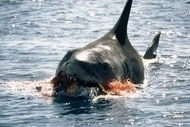Create a free profile to get unlimited access to exclusive videos, sweepstakes, and more!
This new species of 300-million-year-old 'Godzilla Shark' was King of the Lagoon

Representing new insights into how ctenacanths factored into the complicated family tree of sharks, a fearsome new species of 300-million-year-old shark has now been identified from a complete skeleton first unearthed in the Manzano Mountains 30 miles southeast of Albuquerque, New Mexico back in 2013.
Collaborating with the New Mexico Museum of Natural History & Science (NMMNHS), a team of paleontologist from various institutions has officially named the 6.7-foot-long creature Dracopristis hoffmanorum, better known by its more colorful nickname as the "Godzilla Shark."
Dracopristis and other species of ctenacanths are part of a unique evolutionary branch of the sharks that diverged from modern sharks and rays roughly 390 million years ago and became extinct by the end of the Paleozoic Era some 252 million years ago.
The assembled team was led by paleontologist John-Paul Hodnett, the program coordinator for the Maryland-National Capital Parks and Planning Commission’s Dinosaur Park in Laurel, Maryland, and also included Eileen D. Grogan and Richard Lund of St. Joseph’s University in Pennsylvania; Spencer G. Lucas, Curator of Paleontology at NMMNHS; Tom Suazo, former fossil preparator at NMMNHS; David K. Elliot of Northern Arizona University; and Jesse Pruitt of Idaho State University.
"Godzilla Shark" takes its apt alternate name from the 12 rows of lethal teeth set inside powerful jaws and two large dorsal spines displayed on its back similar to the notorious King of the Monsters.
Its official designation, Dracopristis hoffmanorum (Hoffman’s Dragon Shark), honors its kaiju-style attributes and the Hoffman family who own the acreage where this shark fossil was extracted.
Oddly enough, this rare specimen was accidentally discovered during a NMMNHS scientific meeting to the nearby mountains where a bounty of late Pennsylvanian Period plant and animal fossils had been excavated. While packing up to leave, Hodnett, who happened to be a graduate student in 2013, suddenly spied something remarkable.
“I was just sitting in a shady spot using a pocket knife to split and shift through the shaley limestones, not finding much except fragments of plants and a few fish scales, when suddenly I hit something that was a bit denser,” said Hodnett in a University press release. “At first, I thought what was flipped over was the cross-section of a limb bone, which was exciting as no large tetrapod had been found at that site before.”
But it would be 24 hours before scientists returned to the lab at NMMNHS and actually realized the magnitude of the find.
“The Museum fossil preparatory, Tom Suazo, came in with this cardboard tray in his hand and a huge grin on his face, saying that it wasn’t a tetrapod that I found but a really big shark,” noted Hodnett.
Dr. Spencer Lucas, curator of paleontology at NMMNHS, urged Hodnett to conduct more investigations into the fossilized remains of Dracopristis hoffmanorum, a prize that eventually was recognized as the most complete ctenacanth shark fossil ever to be unearthed on the continent.
It took seven years of careful cleaning and stabilizing at the museum lab before more detailed research could be accessed by comparing the features to previously discovered prehistoric sharks.
Judging by the surrounding geology and unique anatomical features of Dragopristis, Hodnett and his team concluded that this Dragon Shark probably swam in shallow lagoons and murky estuaries, where it would lurk along the bottom to munch on crustaceans, bony fish, and smaller sharks.
“In the same rocks that yielded the fossil of Dracopristis, we have found teeth of a larger shark called Glikmanius, which is known almost worldwide at this time, and it would have been a large and dangerous predator” said Hodnett.





























